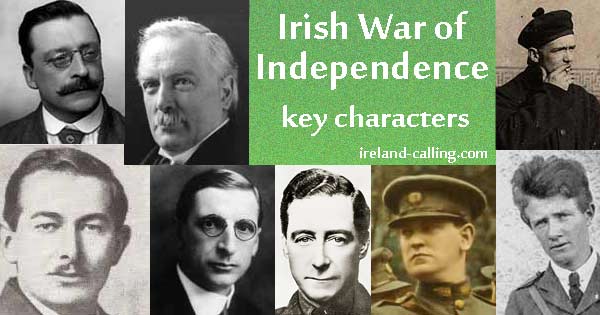The Irish War of Independence involved several different groups and individuals.
It was mainly fought between the IRA and the British Army. However, the fight was also taking place in parliament, both in Ireland and Britain.
The British Army had to draft in reinforcements to maintain control in Ireland, with each group having their own identity. Below are brief summaries of the key characters and groups that took part in the Irish War of Independence.
Éamon de Valera
Éamon De Valera was the leader of Sínn Féin. He had fought in the Easter Rising and was only spared the death penalty because of his American birth.
The British didn’t want to damage relations with the US as they were in the midst of fighting the First World War and were hoping for military support.
De Valera was popular with the Irish public and respected by the British politicians. He also had strong contacts in America that he used to gain financial and political support for the Irish cause.
Michael Collins
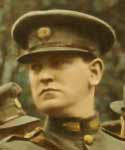
Michael Collins had fought with the Irish rebels at the Easter Rising and had been sent to Frongoch prison in Wales for his role in the rebellion.
There, Collins made useful contacts with numerous Irish nationalists from across the country, and taught them about guerrilla warfare tactics.
Collins had seen how the tactical naivety had cost the rebels during the Easter Rising, and he learnt from their mistakes. He was the intelligence officer for the IRA throughout the War of Independence, and also a member of the Dáil as Finance Minister for Sínn Féin.
Arthur Griffith
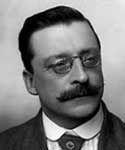
Arthur Griffith founded Sínn Féin in the early 1900s but the party didn’t gather force until after the Easter Rising.
Griffith stepped down as party leader to allow de Valera to take control, but he remained a senior figure.
Griffith was opposed to the IRA’s use of violence, and preferred a national order of disobedience to British authority to achieve independence.
Griffiths was the man who negotiated alongside Collins when they signed the Anglo-Irish Treaty at the end of the war.
Seán Treacy
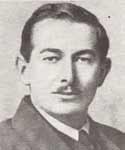 Seán Treacy was one of the leaders of the Tipperary division of the IRA. He was the man who started the war, after he and his troops ambushed and killed two unarmed RIC officers. Treacy was involved in several of the major battles within the war.
Seán Treacy was one of the leaders of the Tipperary division of the IRA. He was the man who started the war, after he and his troops ambushed and killed two unarmed RIC officers. Treacy was involved in several of the major battles within the war.
He successfully rescued Séan Hogan after his arrest, and became part of Michael Collins’ assassination squad.
Sínn Féin
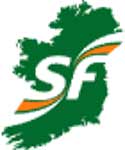 Sínn Féin was the political party that the Irish people had voted for at the 1918 General Election. They were elected to take 70% of the Irish seats for the British parliament.
Sínn Féin was the political party that the Irish people had voted for at the 1918 General Election. They were elected to take 70% of the Irish seats for the British parliament.
The majority of the country was behind them, although they were well behind the Unionists in Ulster where loyalty still lay firmly with the British.
After winning the Irish vote by a landslide, the members of Sínn Féin refused to travel to Westminster to take their seats. Instead, they set up the Dáil in Dublin and began to govern Ireland from Ireland.
Despite several senior members also being members of the IRA, such as de Valera, Collins and Brugha, Sínn Féin had no official association with the IRA and the party itself had not declared war with Britain.
IRA
The Irish Republican Army (IRA) evolved from the Irish Volunteers, the group of rebels that had fought in the Easter Rising.
Several of the Rising leaders had been executed, so it took a couple of years for the group to regain a state of order and hierarchy, until it returned under the name the IRA. Many leading members had become close while being interned at Frongoch prison.
Despite the name, the IRA had no national structure and chain of command, with numerous small brigades all working independently of each other, but towards the same end. Michael Collins was the organisations most prominent figure.
RIC
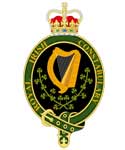 The Royal Irish Constabulary (RIC) was the Irish police force. They were loyal to British rule, and their job was to maintain law and order in Ireland.
The Royal Irish Constabulary (RIC) was the Irish police force. They were loyal to British rule, and their job was to maintain law and order in Ireland.
They were hated by the IRA, who saw them as the eyes and ears of the British government in Ireland. The RIC were frequently targeted for IRA ambushes during the war because they were generally stationed in isolated and vulnerable locations in rural areas, with the British Army maintaining control of the big cities.
It was the IRA killing of two unarmed RIC officers that signalled the start of the war.
British parliament
 David Lloyd George was the British Prime Minister throughout the time of the Irish War of Independence.
David Lloyd George was the British Prime Minister throughout the time of the Irish War of Independence.
He had lost any little support he had in Ireland in 1918, when he attempted to extend conscription for the First World War to Ireland. The move was met with outrage in Ireland, and was never put into force.
Lloyd George oversaw the Government of Ireland Act in 1920, which recognised the island being politically split into two clear regions of north and south. However, this act couldn’t be put into force either because the war was still taking place.
Black and Tans
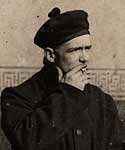 The Black and Tans were a group of former WWI soldiers drafted in by the British government to help bring an end to the IRA’s campaign in Ireland.
The Black and Tans were a group of former WWI soldiers drafted in by the British government to help bring an end to the IRA’s campaign in Ireland.
They were generally veteran soldiers who were scarred by what they had seen on the battlefield, and often had little sense of empathy or humanity.
The Black and Tans had a reputation for being drunk, aggressive thugs, and regularly beat and abused suspected members of the IRA. They also looted and destroyed whole towns at a time, particularly when hungry for revenge after one of their own had been killed.
The Squad
The squad was a group of elite IRA volunteers hand-picked to form an assassination unit at Collins’ request. Also known as the ‘Twelve Apostles’, the squad were paid a weekly wage and ordered to carry out the most dangerous and expert missions.
They were generally ordered to kill high-profile British officials, but also anyone that could pose a threat to the IRA operations. On the morning of Bloody Sunday, the squad executed fourteen members of the Cairo Gang and one Black and Tan in what was a highly successful mission for the IRA.
Cairo Gang
The Cairo Gang was a group of experienced British secret agents and spies that were drafted in to combat the IRA guerrilla tactics.
They got their name either because they included members of the British secret service that had been stationed in Cairo during the First World War, or because they regularly met at the Cairo Café in Dublin. 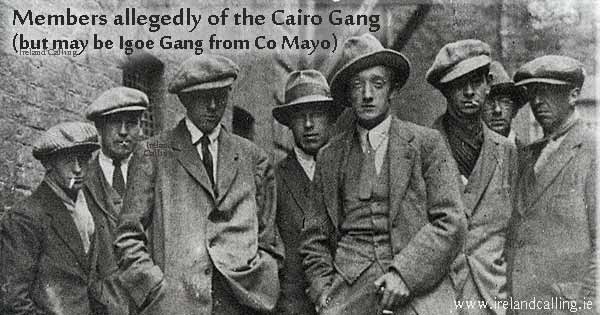 The Cairo Gang were intelligent, cunning and ruthless. They attempted to flush out members of the squad by executing high profile figures in Sínn Féin.
The Cairo Gang were intelligent, cunning and ruthless. They attempted to flush out members of the squad by executing high profile figures in Sínn Féin.
Collins and the rest of the IRA feared the Cairo Gang because of their cunning and ruthlessness. Collins ordered the assassination of several members of the Cairo Gang in the Bloody Sunday attacks.
Irish History – quick, easy-to-read summaries
Easter Rising 1916 – six days that changed course of history
